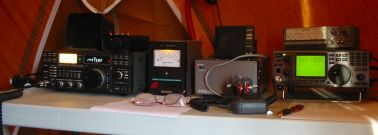Becoming Licensed
Introduction
In return for being granted spectrum access radio amateurs must pass exams in radio (the theory exam) and the regulations affecting amateur operation. The purpose of the exams is to ensure that licensees can build and operate radio equipment without causing interference to others. Unlike all other spectrum users, radio amateurs are allowed to build or modify transmitting equipment, and do not need to obtain type-approval for it. Licensed amateurs can also use any frequency in their bands (rather than being allocated fixed frequencies or channels) and can operate medium to high-powered equipment on a wide range of frequencies.
To get an amateur licence, you need to:
- Study regulations and radio theory - either through coursework or as an independent student
- Arrange for and sit the desired tests
- Await results from the Wireless Institute of Australia
- Submit evidence of your pass to the Australian Communications and Media Authority, which will issue a Certificate of Proficiency, issue a licence and allocate a callsign.
The following paragraphs explain the categories of licences available, privileges granted and the exams required. The remainder of this article will explain often overlooked, but important matters such as studying, arranging an exam and obtaining a license.
Categories of Licence
Australia now has three licence classes. (updated 19 October 05, the date of commencement of the new arrangements)
- The amateur Foundation licence. Holders of the Foundation licence can only use a transmitter that has been manufactured commercially, can only use voice, on either SSB, AM or FM or morse using a manually operated morse key, and not more than 10 watts output power on SSB, AM, FM or CW. Bands permitted are the 80, 40, 15 and 10 metre bands as well as the 2 metre band and the band 430 to 450 MHz, subject to necessary bandwidth restrictions.
- The Amateur Standard licence includes the existing Novice, and Novice Limited licensees, who can use any emission mode with a necessary bandwidth not exceeding 8 kHz on the 80, 40, 20 and 15 metre bands, and any emission mode with a necessary bandwidth not exceeding 16 kHz on the 10 metre band, the band 52 to 54 MHz, the 2 metre band, and the bands 430 to 450 MHz, 1240 to 1300 MHz, 2,400 to 2,450 MHz and 5.650 to 5.850 GHz, with no change to the current output power limits of 100 watts (PEP for SSB) and 30 watts (constant carrier modes).
- The Advanced licence includes the previously named Unrestricted licence, the Limited licence and the Intermediate licence. Advanced licencees can use any emission mode with a necessary bandwidth not exceeding 8 kHz on all bands below 24.990 MHz, any emission mode with a necessary bandwidth not exceeding 16 kHz on the 28.00 MHz to 29.70 MHz band, any emission mode with a necessary bandwidth not exceeding 100 kHz on the 6 and 2 metre bands and any emission mode with no bandwidth restriction in the amateur bands above 420 MHz, and with power limits of 400 watts (PEP for SSB) and 120 watts (for constant carrier modes).
Next: How to get a licence

